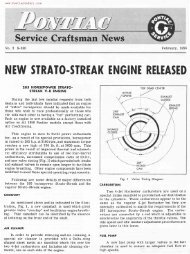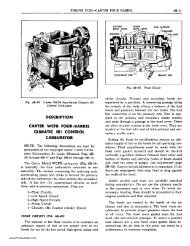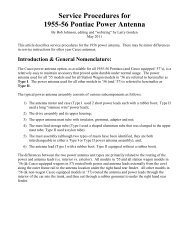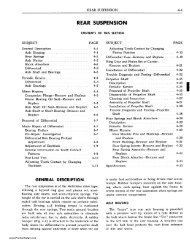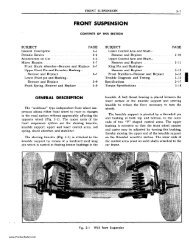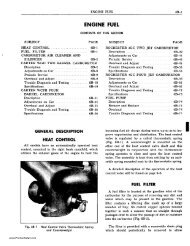You also want an ePaper? Increase the reach of your titles
YUMPU automatically turns print PDFs into web optimized ePapers that Google loves.
<strong>POWER</strong> <strong>STEERING</strong> 9-11<br />
OIL FLOW IN NEUTRAL<br />
When the steering wheel is not being turned or is<br />
turned with a force of less than three pounds, the<br />
spool valve will remain centered as shown in Fig. 9-2l.<br />
Pump output will then be directed from the pressure<br />
inlet of the valve body past the spool valve to the return<br />
line to the reservoir. This pump output will<br />
simply be recirculated in the system without doing<br />
any work.<br />
OIL FLOW DURING TURNS<br />
When the steering wheel is turned, a thrust will be<br />
developed between the pitman shaft and the ball nut.<br />
This thrust will increase as the steering effort at the<br />
steering wheel increases. When the effort at the wheel<br />
reaches three pounds, the force on the ball nut will<br />
move the steering shaft, compressing the plunger<br />
springs and moving the spool valve with it.<br />
When the spool valve moves as shown in Fig. 9-22<br />
on a left turn, oil is directed past the spool valve to<br />
the left side of the power piston. This pushes the<br />
piston to the right, assisting the driver in turning the<br />
wheel. Oil from the other side of the piston is directed<br />
back through the valve body to the pump reservoir.<br />
In addition oil pressure is directed against the spool<br />
centering plungers to supplement spring force in trying<br />
to center the spool. This causes the force required<br />
to turn the wheel to increase as the front wheels get<br />
harder to turn, giving the driver a natural feel of<br />
steering.<br />
When making a right turn the steering shaft and<br />
spool move in the opposite direction. This directs<br />
pressure to the opposite side of the piston. Oil flow<br />
is similar to that when making a left turn except it is<br />
in the opposite direction.<br />
A check valve in the control valve body allows the<br />
flow of oil from one side of the piston to the other,<br />
permitting normal manual steering of the car in case<br />
of pump failure.<br />
DESCRIPTION OF OPERATION OF<br />
<strong>POWER</strong> s.TEERING <strong>PUMP</strong><br />
The vane type pump is a positive displacement<br />
pump. Oil from the reservoir enters the pump body<br />
and is picked up by rotor vanes through two inlet<br />
ports and pockets and discharged under pressure<br />
through outlet ports in the pump pressure plate (Fig.<br />
9-23 and 9-24). Sufficient oil under pressure is directed<br />
['ill HIGH PRESSURE OIL<br />
mJ LOW PRESSURE<br />
RETURN OIL<br />
R RVOIR<br />
-<br />
SCHEMATIC DRAWING OF HYDRAULIC BOOST<br />
IN LEFT TURN POSITION<br />
(<br />
Fig. 9-22<br />
Operation of Power Steering Unit During Left Turn<br />
www.PontiacSafari.com



